







|
It’s Sugarin’ Time
Indiana’s Maple Syrup Tradition
January here in Indiana ended on a cold note, and if the weather cooperates, February should bring us cold nights and warmer days. This is just the weather Indiana’s maple syrup producers are hoping for.
That’s right - Indiana’s maple syrup producers! While we’re not known for our syrup like New England or Canada, there are plenty of good quality maple products made right here. Indiana is basically at the southern edge of maple syrup country. We produce less syrup than the northeastern states, but you might be surprised by how much is produced in Indiana.
It’s true, not everyone knows about Indiana’s quality maple syrup. In fact, on a visit to a maple syrup camp in New Hampshire, Florence Williams, Director of the Indiana Maple Syrup Association was told, “There is no maple syrup produced in Indiana.” Oh yes there is! In fact, Florence tells us the most recent “very rough estimate” is that about 10,000 gallons of syrup are produced annually in Indiana. The quality is equal to any other region’s, but Indiana doesn’t have the conditions to produce as much.
Making Maple Syrup
All it takes to make maple syrup is a mature sugar maple tree (Acer saccharum) or two, a suitable climate like Indiana’s, and a little equipment. The first step is to identify a sugar maple. While any of the maples native to the northeast produce sap in the spring, the sugar maple has the highest sugar content, at around 3%. Keep in mind that it’s easier to identify the sugar maples before the leaves are gone for the winter. The sugar maple can be identified by the shape of its leaves, and also be its brilliant pink, yellow, and orange fall foliage.
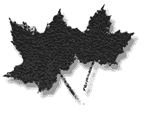 |
| The leaves of the sugar maple have five lobes with smooth rather than serrated edges. They also have a U-sinus, not a V-sinus. |
Making maple syrup is really a simple process: collect sap from the maple tree, then boil it down to the right consistency. There is nothing added to “Pure Maple Syrup”.
Tapping the Tree
The tree should be at least 10” in diameter. Larger trees can hold more than one tap. A rule of thumb is one tap for every additional 8” of diameter. A hole is drilled into the tree with a 7/16” drill bit, to about 1 1/2” into good wood. The hole is drilled at a slight angle to allow the sap to run down the “spout”.
 The tap, or spile, is tapped firmly into the tree and a bucket hung from the spile to collect the ever-so-slightly sweet sap. Most maple sugarers call this “water” because that’s about what it tastes and looks like. A cover is used to keep rain, snow and debris out while the sap is collected. On a sunny day the sap runs out the spout in a continuous stream. The tap, or spile, is tapped firmly into the tree and a bucket hung from the spile to collect the ever-so-slightly sweet sap. Most maple sugarers call this “water” because that’s about what it tastes and looks like. A cover is used to keep rain, snow and debris out while the sap is collected. On a sunny day the sap runs out the spout in a continuous stream.
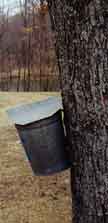 Some producers have replaced the traditional galvanized syrup buckets with plastic bags. Elaborate tubing systems are also used today, connecting trees throughout the “sugar bush” or maple forest. The tubing acts as a pipeline carrying sap to a holding tank. Some producers have replaced the traditional galvanized syrup buckets with plastic bags. Elaborate tubing systems are also used today, connecting trees throughout the “sugar bush” or maple forest. The tubing acts as a pipeline carrying sap to a holding tank.
The sap then gets boiled down. It is put into an evaporating pan and heated, usually over a wood fire. Depending on the volume of sap, evaporators can range from very elaborate stainless steel versions, to backyard contraptions made with concrete blocks, a 50-gallon barrel, and a large pan. The evaporator is sometimes housed in a “sugar shack”, or at a place in the woods called a “sugar camp”, where the syrup is made. The evaporating process can take several hours. Most syrup makers share memories of camping out in the sugar shack all night, feeding the fire.
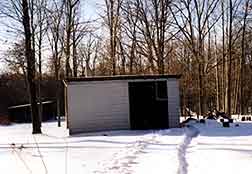
|
|
A backyard sugar shack in Southern Indiana
|
As the syrup thickens it goes to a finishing pan, and is cooked to a precise consistency. At this point it needs to be carefully watched. One test for doneness is the “aproning” test. When a spatula is placed in the syrup it should run off in an aproning effect, rather than by drops. Or it can be heated to 7 to 7 1/2 degrees above the boiling point of water.
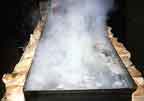
|
|
It takes 20 to 60 gallons of sap to make a single gallon of syrup. This releases a lot of steam! It has been known to steam the wallpaper right off of people’s walls.
|
 When the syrup is finished it should be taken off the heat and bottled quickly. Before bottling, the syrup goes through the last of several filterings. Cooking past the syrup stage makes maple sugar, and the hard, crystallized rock candy. When the syrup is finished it should be taken off the heat and bottled quickly. Before bottling, the syrup goes through the last of several filterings. Cooking past the syrup stage makes maple sugar, and the hard, crystallized rock candy.
If you’ve ever tasted maple syrup you know that there is nothing like it. If you haven’t, you need to treat yourself better! You shouldn’t have to go far to find “Pure Indiana Maple Syrup”, and once you’ve tried it, you won’t want to settle for less.
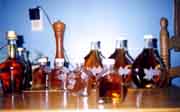
|
Parke County Maple Syrup Festival
If you’ve never seen maple syrup produced, don’t miss the Parke County Maple Syrup Festival Feb. 26-27 and March 4-5. See tapped trees, smell the sweet steam for yourself, and taste some of Indiana’s finest natural goodness! You can visit several different working sugar camps, either by picking up a map and driving, or by taking the bus tour. Maps are available at the Parke County 4-H Fairgrounds, one mile north of Rockville on Indiana 41.
Festival hours are 8am-5pm.
Enjoy pancakes, sausage and maple syrup meals from 8-5 in the 4-H Building, and see displays of Parke County Maple Syrup Producers. Other parts of Parke County, including Billie Creek Village, Rockville Town Square, Bridgeton Historic District, and Mansfield will host other related activities. For more information, call the Covered Bridge Tourist Center at 765-569-5226.
Indiana Maple Syrup Association
The Indiana Maple Syrup Association is open to any maple syrup producer, from novice backyard sugarers to professionals. There are around 80 members this year, who meet once a year. Members receive the Tapline Newsletter. Each year the IMSA runs a sugar shack at Pioneer Village during the Indiana State Fair. Fairgoers can sample Pure Indiana Maple Syrup, buy products, and see first-hand how maple syrup is produced. For information call Director Florence Williams of Rockville, at 765-569-3704, Director Garry Sink of Roanoke, Indiana at 219-638-4919 or President Steve Deatline of Lynn, Indiana at 765-874-2170.

|